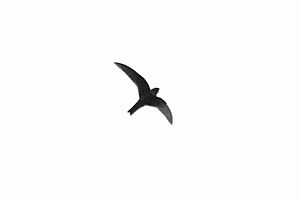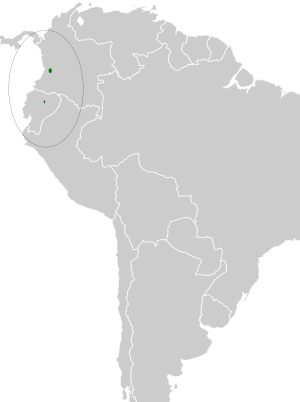White-chested swift facts for kids
Quick facts for kids White-chested swift |
|
|---|---|
 |
|
| Conservation status | |
| Scientific classification | |
| Genus: |
Cypseloides
|
| Species: |
lemosi
|
 |
|
The white-chested swift (Cypseloides lemosi) is a special type of bird. It belongs to the swift family, known for their fast flight. You can find this bird in countries like Bolivia, Colombia, Ecuador, and Peru. It might also live in Brazil, but this is not fully confirmed.
Contents
About the White-Chested Swift
What's in a Name?
Scientists group the white-chested swift with a few other swifts. These include the American black swift, Rothschild's swift, and sooty swift. They are all very similar, like close relatives. The white-chested swift is a unique species on its own.
What Does It Look Like?
The white-chested swift is about 14 to 15 centimeters (5.5 to 5.9 inches) long. It weighs around 28 grams (1 ounce), which is very light! Both male and female birds look the same. They have a tail that looks notched, or V-shaped. The male's tail notch is a bit deeper.
Their feathers are mostly a dark, sooty black color. Their upper body, like their back and head, has a slight green shine. Their wings and tail look a bit bluish. The area around their eyes is black. The most special part is a large white patch across their chest. This patch is wider in the middle. The rest of their belly is lighter and brownish. Young white-chested swifts do not have this white chest band. They are dark gray with white tips on their belly feathers.
Where Does It Live?
The white-chested swift has been seen in many different places. These include the Cauca River valley in Colombia. They also live along the eastern side of the Andes mountains in Ecuador. From there, they go south into Peru, as far as the Cuzco area. They are also found in Bolivia.
There was one sighting in Brazil, but it's not officially confirmed. So, scientists are not sure if they truly live there. These birds usually fly over evergreen forests in mountains and lowlands. But they can also be seen over pastures and younger forests that are growing back.
How the White-Chested Swift Lives
Does It Migrate?
Scientists don't know much about where white-chested swifts build their nests. Because of this, it's hard to tell if they stay in one place all year or if they travel to different areas.
What Does It Eat?
Like all swifts, the white-chested swift catches insects while flying. They are called "aerial insectivores." We don't know exactly what all they eat. But people have seen them eating small beetles. They often fly and hunt for food in groups. Sometimes, they even join other types of swifts.
Life Cycle and Reproduction
We still have a lot to learn about how white-chested swifts raise their young. Scientists think they might build their nests on cliffs near water. This is because other swifts in their family do this.
What Sounds Does It Make?
The white-chested swift makes quick, high-pitched calls. People describe their calls as a fast "pi'pi'pi-pee pee." They also make single "tip" and "pee" sounds.
Conservation Status
The IUCN (International Union for Conservation of Nature) has looked at the white-chested swift. They have listed it as a species of "Least Concern." This means it's not in immediate danger of disappearing. However, its known living area is small. We also don't know how many of these birds there are. Scientists believe their numbers might be going down.
No big threats have been found for them right now. It's hard to fully understand their conservation status. This is because we still need to find out where they build their nests and raise their young.
See also
 In Spanish: Vencejo pechiblanco para niños
In Spanish: Vencejo pechiblanco para niños


